Everything began when Leo was just two years old – and I myself hadn’t even seen the light of day.
And yet, an unassuming groundbreaking in Mals would go on to change our lives.
No one could have guessed that this moment already held the blueprint for our future as FinKa hosts.
1968 – a year that would not only shape our future but become the very symbol of an entire way of life.
The Beatles were topping the charts with the White Album, hippie dresses fluttered in the summer breeze, and humankind was on the verge of reaching the moon.
And in Mals? They were pouring the foundation for a new financial barracks – the same ground where, fifty years later, the travel world of Val Venosta would find its own groove.
That barracks would one day become the FinKa Hostel.
The Construction of the Barracks
If you want to tell the story of the FinKa Hostel – from barracks to hostel – you can’t skip one man: Josef, or as everyone called him, Giuseppe Theiner.
Back then, better known as The Mohrenwirt of Burgeis – an innkeeper, businessman, and shrewd judge of people with a knack for lucrative deals.
On behalf of the Guardia di Finanza, he had a new barracks built on his property on Bahnhofstraße in Mals.
The deal was as simple as it was clever: Giuseppe financed the construction himself, and the Italian Financial Police would rent the completed building on a long-term lease.
In July 1968, the first shovel hit the ground, and by December of the same year, Giuseppe proudly held the official certificate of occupancy in his hands. The rental agreement was signed for the tidy sum of 3 million lire per year, and soon after, the Fiamme Gialle – the “yellow flames” of the Guardia di Finanza – moved into their new quarters in Mals.
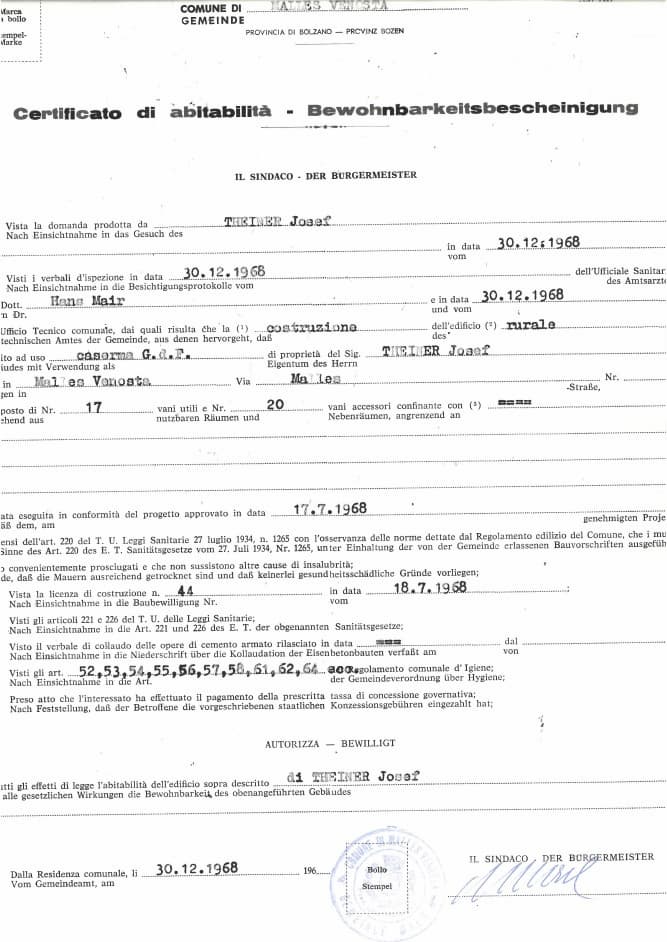
The Inauguration with the Cardinal from Palermo.
August 1969. The sun beat down on the freshly paved driveway of the new barracks.
There was a buzz in Bahnhofstraße: dignitaries from near and far had arrived for the inauguration.
The Italian tricolour waved proudly from the flagpole, and a ribbon in the same colours was stretched across the entrance door.
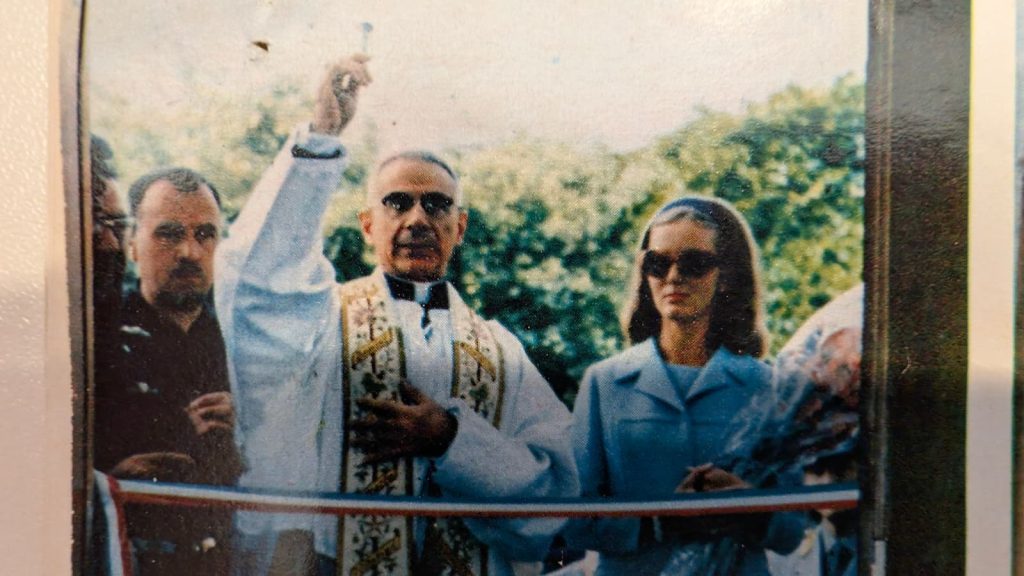
The blessing was given by none other than His Eminence Monsignor Francesco Carpino, Archbishop and Cardinal of Palermo. With a calm gesture, he raised his hand and spoke the words of blessing as incense drifted through the warm summer air and the crowd fell silent in reverence. Only the cameras of the press clicked, capturing this moment — suspended between devotion and new beginnings — for eternity.
Following the blessing, the commander of the barracks, Captain Corrado, took the floor: “This day marks a new chapter for our command. We now have headquarters that meet every operational need — especially for anti-smuggling operations along the borders of Upper Val Venosta and down in the valley. In this three-storey building, around forty members of the Guardia di Finanza will find a new home — a place to live and work.”
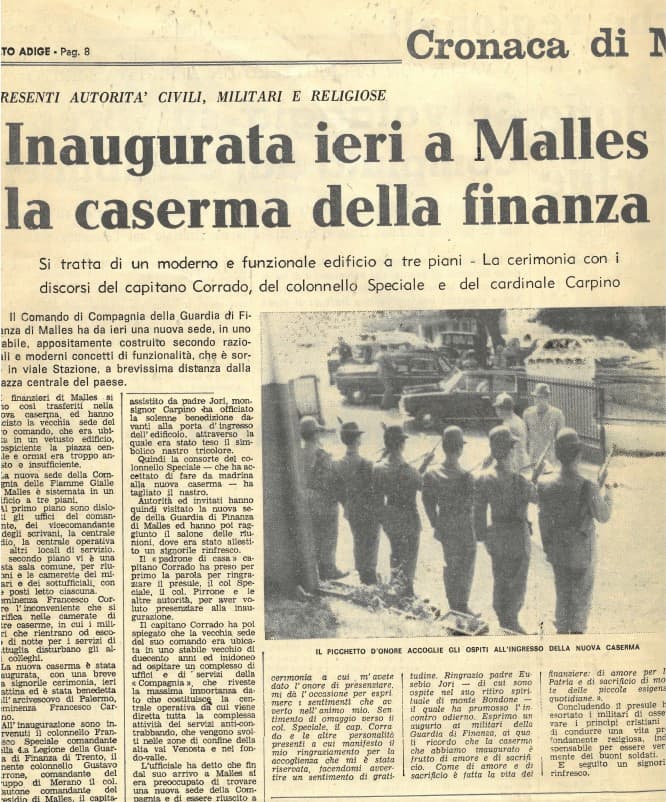
And so it remained until 2005, when the unit was disbanded and the last officers moved out.
The gates closed. For fifteen long years, the building stood silent and shuttered – a sleeping giant at the edge of Mals, left to the slow decay of time.
Plan B – and Suddenly, Everything Was Possible.
Spring 2019. Juliane and I stood before that same iron gate, waiting for Rudi Theiner – Giuseppe’s son – to show us the old barracks. At that point, our visit had absolutely nothing to do with a hostel.
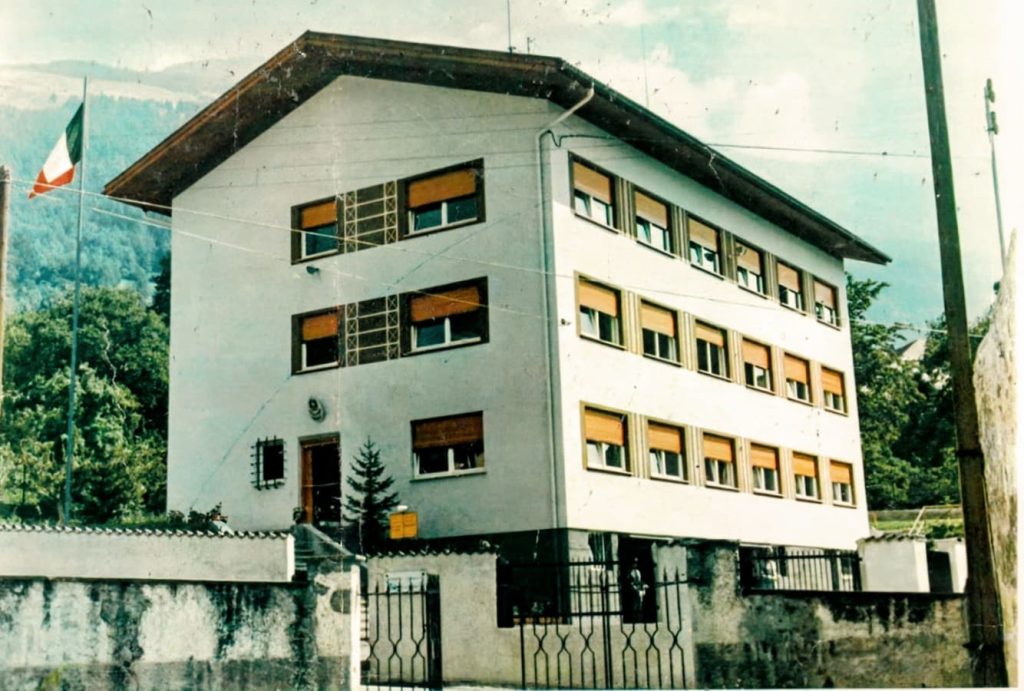
We were there on behalf of VISO, our social cooperative, to explore a proposal with a major South Tyrolean aid organisation: turning the former barracks into worker housing.
Weeks of meetings followed – calculations, discussions, endless paperwork. We sat around tables with representatives, politicians, and officials, all searching for a way to make the project financially viable.
Budgets were adjusted, recalculated, and ultimately abandoned. Eventually, everyone realised: Plan A was doomed. The costs ran away from us; the subsidies weren’t enough; even the most motivated calculator had had enough.
When the project was finally shelved, no one shed a tear.
In fact, it felt wonderful. Because from the very first visit, Juliane and I had felt that this old barracks was meant for something entirely different – something alive, open, maybe even one of a kind.
At the moment Plan A collapsed, our Plan B shot straight into the realm of the possible. That crazy idea that had been growing quietly in our minds suddenly became real: turning the old Guardia di Finanza barracks into a hostel.
Bringing it into a new era.
And so we began, step by step, to usher in a new chapter – one that would bridge past and future in a natural, unpretentious way.
Turning the Idea Upside Down.
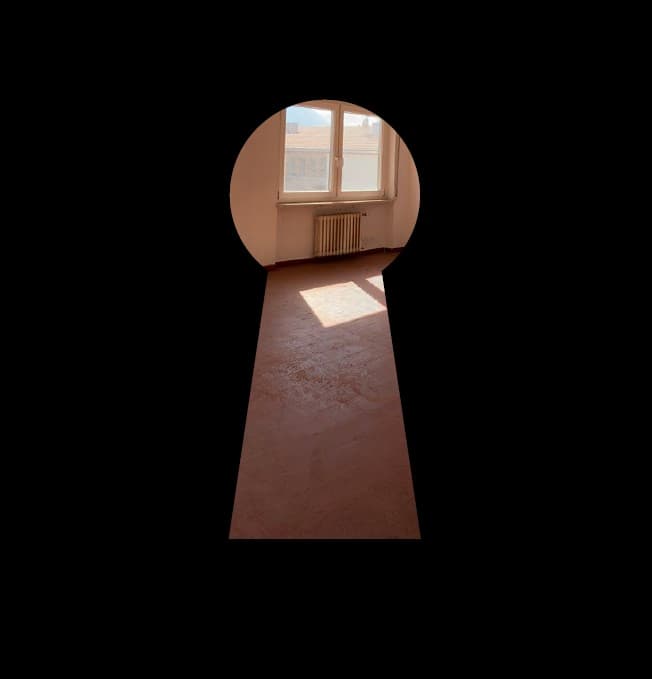
Now it was time to get serious. From every side came new bureaucratic hurdles. From above pressed the purchase price; from below, we had to shore it up with our own capital and loans – all the joys of buying and transforming a barracks into a hostel.
It was no walk in the park. Every step brought new forms, new questions, new challenges. But on December 12, 2019, we finally held the preliminary purchase contract in our hands.
Then came COVID. The world froze. We asked ourselves whether to pause or push forward. But true to our motto “Courage pays off”, we hit the gas again.
And so, on April 16, 2020, in the middle of lockdown, I drove alone across empty roads to Merano to sign the final deed. In my bag: three cheques and a big dream. By the end of the day, it was done – the sale was sealed, the keys were ours, and the transformation could begin.
The Transformation into the FinKa Hostel – 50 Years Later
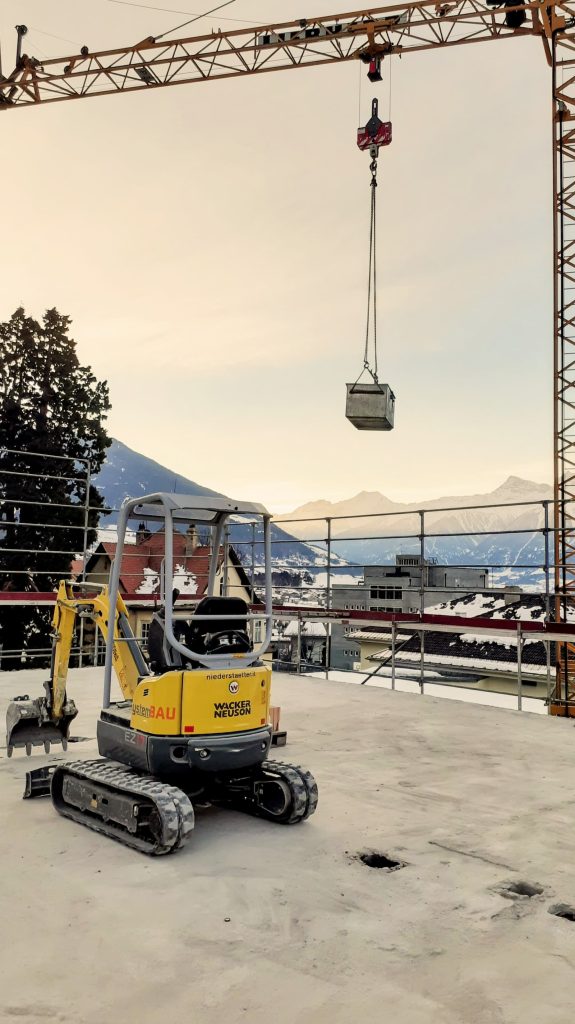
It was anything but ideal to start a renovation during a pandemic. While the rest of the world pressed pause, we started planning, calculating, and working.
Together with architect Jürgen Wallnöfer, we began shaping our vision. Our top priority: to preserve the character of the building – while giving it a new soul.
The concept was clear: preservation instead of demolition.
A place like this doesn’t just hold physical substance or “embodied energy” – it carries decades of human stories, memories, and meaning.
We didn’t want to destroy, but to reuse everything we could. In the end, the renovation became a mix of improvisation, upcycling, craftsmanship, and stubborn determination – and maybe that’s what made it so exciting and alive.
The big steps were quickly defined: the new elevator shaft, the external fire stairs, and the roof floor, which we removed completely and rebuilt in modern timber construction. That’s where today’s rooftop suites are – filled with light, open, and in perfect dialogue with the old structure.
Inside, walls were moved, new openings created, old ones closed. Each room got its own bathroom – a comfort the financial officers back in the day could only have dreamed of.
We thought ahead, too: district heating connection, photovoltaic panels on the roof and terrace railing – today we cover about 55% of our energy needs that way.
Thus, from concrete grew character – a building reborn with purpose, sustainability, and soul.
All the craftsmen came from Val Venosta – builders, carpenters, electricians, plumbers, painters.
That wasn’t by chance: we wanted the value to stay where it belongs – in the valley.
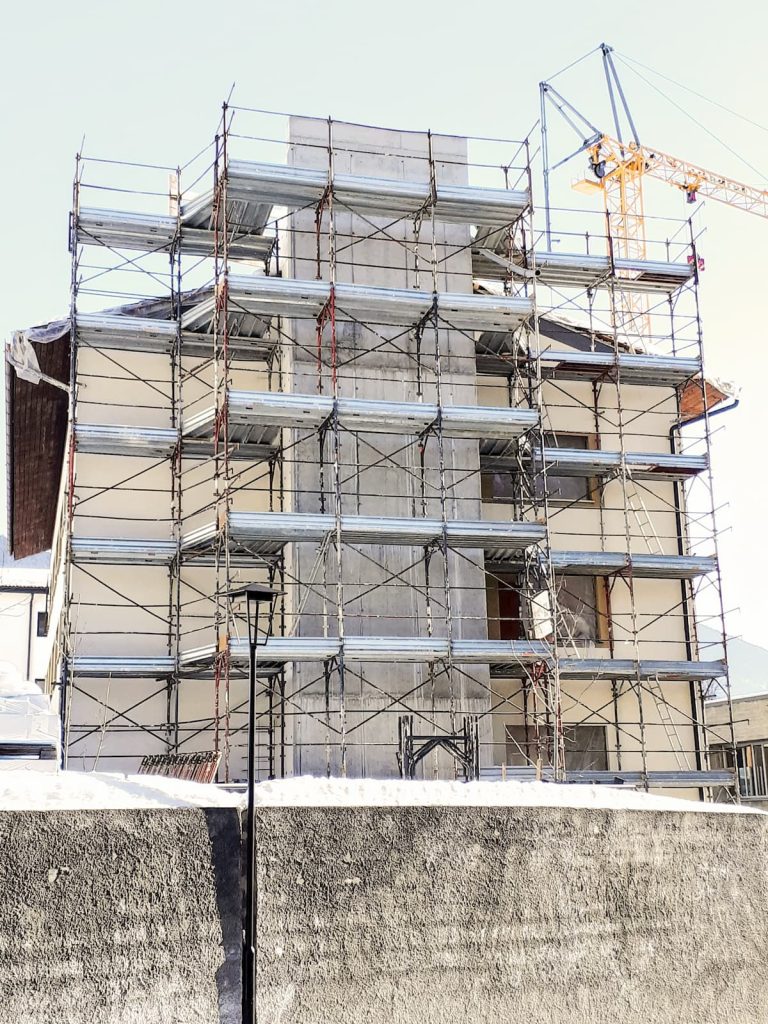
The collaboration was marked by skill, experience, and healthy improvisation. Solutions often emerged right on site – spontaneous, practical, and spot on.
The crowning touch came from Esther Stocker, whose black-and-white artwork now adorns the elevator shaft.
Based on her design, geometric forms were applied over 3 × 16 meters of façade – seemingly random yet perfectly balanced. With that, the FinKa in Mals joined the long list of buildings worldwide bearing Esther Stocker’s unmistakable signature.
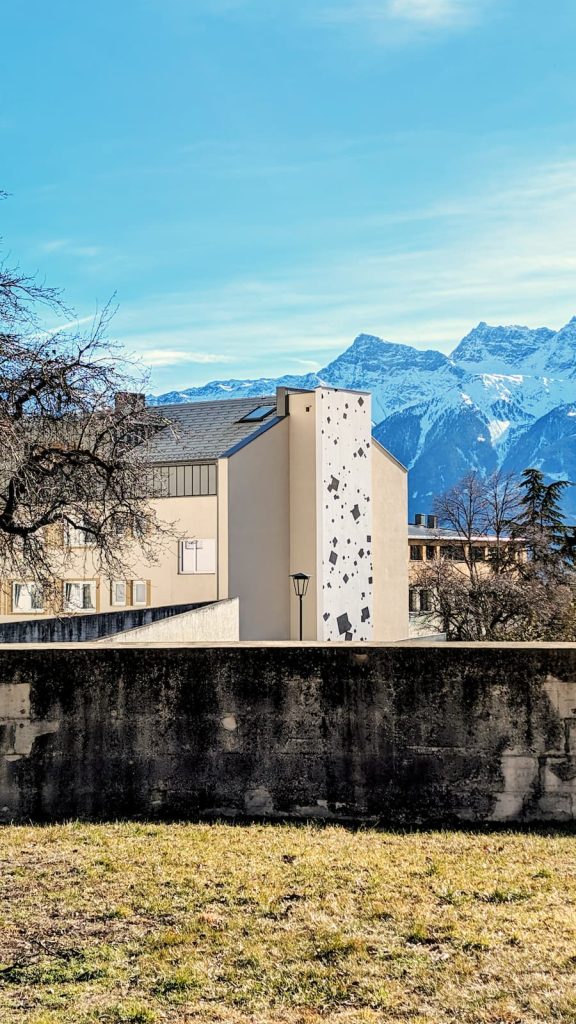
The Opening of the FinKa Hostel – A New Era
Summer 2021. The FinKa opened its doors. A new chapter began. What was once a place of control and command had become a space for encounters. Travellers from all over the world now come to stay, to breathe, to experience Val Venosta in their own rhythm. It’s almost as if the old barracks had always been waiting – to become exactly this: a home for stories and souls in motion.
Oh – there’s Leo calling from the kitchen. Work awaits. After all, our guests won’t get full on words alone. Time to finish the Knödel for dinner.
In Short:
From a guarded post to an open house: The story of the FinKa Hostel begins in 1968 with the construction of the Guardia di Finanza barracks in Mals – and, more than fifty years later, finds its rebirth as a hostel with heart.
Giuseppe Theiner, innkeeper and entrepreneur, once built it for the Financial Police. After years of silence, VISO Social Cooperative rediscovered its potential in 2019. With courage, creativity, and persistence, concrete became history – and history became future.
Today, the FinKa stands for what happens when you don’t demolish the old, but breathe new life into it:
a place of encounters, honest and alive – from the Esther Stocker façade to the kitchen, where Leo prepares the evening Knödel.
What is VISO?
The VISO Social Cooperative was founded in 2013 in Mals. Its mission: to create employment opportunities for people with disabilities and to integrate them into the labour market. In addition to cleaning services, VISO runs two student homes with canteens – and since 2021, also the FinKa. The transformation of the old Guardia di Finanza barracks was one of its boldest projects: social, sustainable, and unmistakably local.
What Does “FinKa” Mean?
The name plays on the building’s history (Finanzkaserne) and echoes the Spanish word finca – evoking sun, hospitality, and joie de vivre. A name that bridges old and new, South Tyrol and the wider world.
What Makes the FinKa Hostel Special?
The FinKa isn’t a hotel – it’s a hostel with attitude. Old substance meets new ideas: vintage furniture, sustainable materials, a terrace with views of the Ortler, and a good dose of soul. Here, life can stay imperfect, real, and full of surprise.
Who Is Esther Stocker?
Esther Stocker is an internationally renowned artist from South Tyrol. Born in Schlanders, now based in Vienna, she is known for her geometric, black-and-white works that explore perception and space. Her art can be found in museums, galleries, and public buildings around the world.
What Does Her Artwork at the FinKa Represent?
Her 3 × 16 meter façade piece on the FinKa plays with movement, order, and perspective – a bold visual statement marking the transformation from control to openness.
Why Preserve Instead of Demolish?
Because old buildings hold more than bricks and mortar. They contain energy, labour, and history – what we now call embodied energy. Demolition would have erased all of that. Instead, we wanted to show that with respect, creativity, and craftsmanship, something new can arise without denying the old. Preserve instead of demolish – that became our guiding thread, both architecturally and philosophically. And so, from a place of control, we created a space of openness.
Can You Just Drop By?
Absolutely. Whether for a night, a coffee in the garden, a living-room concert, or just to say hi – the FinKa’s doors are open.
Want to Be Part of the Story?
📩 Bookings & Reservations:
info@finka.it
📞 Phone: +39 0473 427040
🌐 www.finka.it
Sources:
Esther Stocker
https://de.wikipedia.org/wiki/Esther_Stocker
https://www.estherstocker.net/
On the philosophy “Never demolish. Always transform.”
Never demolish. Always transform.

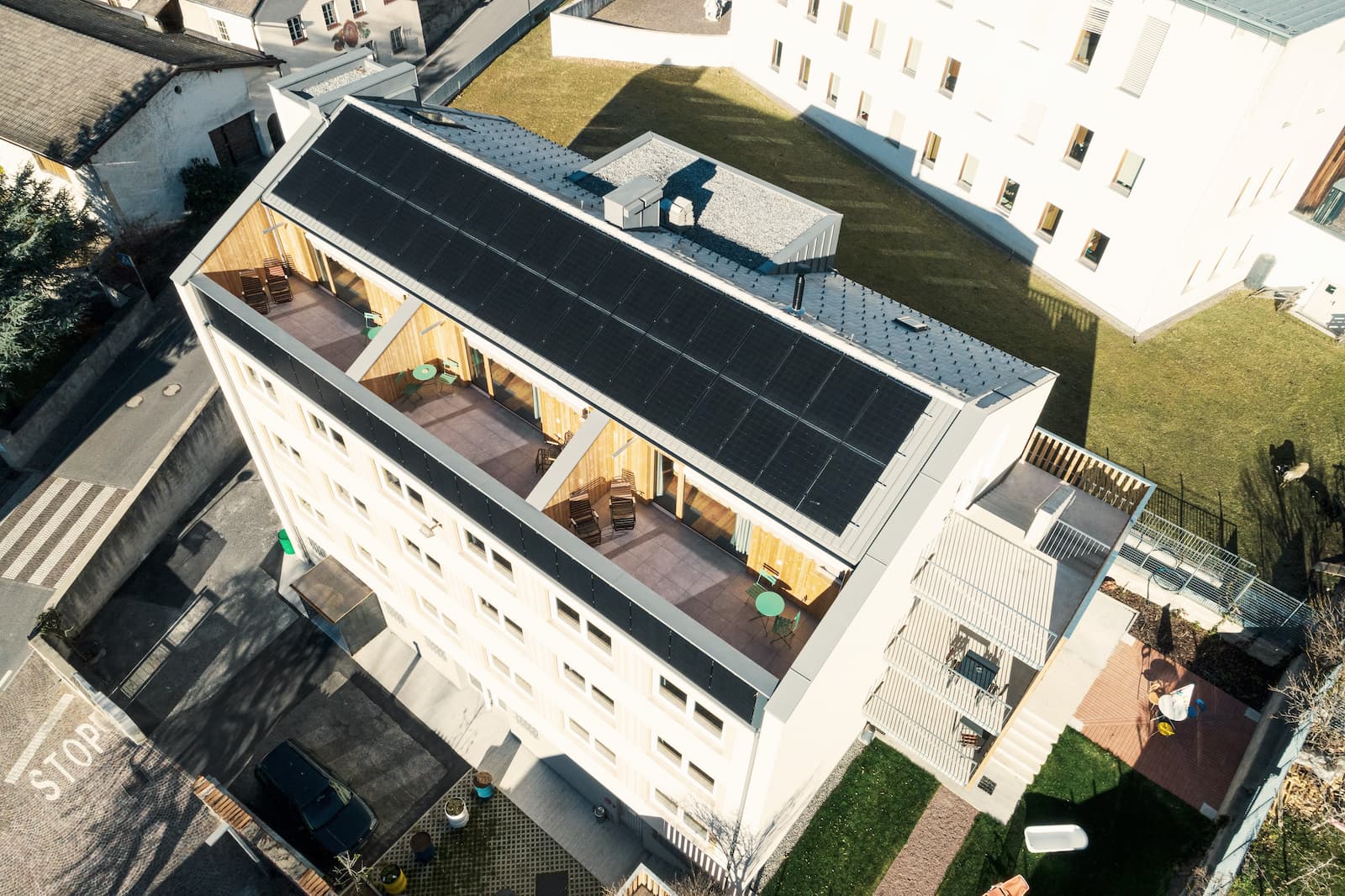
0 Comments